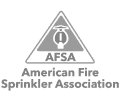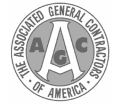Fire Protection and Fire Safety Equipment FAQs
As a local business owner, you know that keeping your building’s fire extinguishers, fire sprinklers, and fire alarm systems well-maintained, regularly inspected, and frequently tested is just another facet of owning property or an office space in the Houston area. By keeping your fire protection system in proper working order at all times, you can help prevent devastating damage and loss from a fire emergency.
However, once their fire protection systems are installed, many people are still unclear on exactly how their fire protection systems work and how their property is protected. We’ve put together a source to answer the most commonly asked questions about fire protection! Our fire protection technicians at Kauffman Co. have decades of experience not only with installation and maintenance, but also answering all your questions to ensure that you have the best information possible about your fire protection systems.
Have a question that isn’t addressed here? Give us a call or contact us today and we will be happy to answer anything!
services from Kauffman
Fire Alarm FAQs
What are the different types of fire alarms?
There are two major types of fire alarms: ionization fire alarms and photoelectric fire alarms. Ionization fire alarms detect flaming, fast moving fires – curtain fires, trash can fires, etc. Photoelectric fire alarms are best for smoky, smoldering fires, such as electrical fires that start out behind walls. There are also dual sensor fire alarms which, naturally, combine both types into one. To maximize your fire protection, you should install both types (or a combination of the two) to make sure you are completely covered.
Do I need both a fire alarm system and a sprinkler system?
In short, yes. Fire sprinkler systems are great for putting out fires after they start, but they only come on once the fire has reached a certain temperature, at which point it will have already done damage. Fire alarm systems, particularly smoke detectors, round out your fire protection because they detect smoke and other gases before the flames start, giving you extra time to escape the building. They can also automatically alert the fire department.
Is fire alarm monitoring worth it?
Fire alarm monitoring is basically a guarantee your building has eyes on it 24/7, keeping it protected from fires at all times. If the fire alarms go off in your building, the fire alarm monitoring company will notify the fire department within seconds – even if you’re not there, or if you’re in the process of safely evacuating. Everyone has heard horror stories of people showing up to work and seeing the charred wreckage of what was once their office (and all their equipment, data, etc.) – don’t let this happen to you!
How long will a fire alarm last?
When properly maintained, your fire alarms should last around 10 – 12 years. After this, you should start thinking about replacing the alarms in your home or building, even if they seem to be working fine – you don’t want to take any chances when it comes to the safety of your employees or family. Plus, replacing fire alarms is fairly inexpensive.
What is the difference between conventional and addressable fire alarms?
Conventional fire alarms are ideal for small buildings such as homes, individual offices, or retail shops. Conventional fire alarms go off when they detect smoke in their immediate vicinity and are perfect for evacuating people from a small space.
Addressable fire alarms are more useful for large buildings or building complexes. The biggest difference between addressable and conventional fire alarm systems is addressable fire alarms have an enunciator panel that shows you (or, more importantly, the fire department) exactly which devices are going off so you can get the proper resources to them as quickly as possible.
What are the different types of fire alarms?
There are two major types of fire alarms: ionization fire alarms and photoelectric fire alarms. Ionization fire alarms detect flaming, fast-moving fires – curtain fires, trash can fires, etc. Photoelectric fire alarms are best for smoky, smoldering fires, such as electrical fires that start out behind walls. There are also dual sensor fire alarms which, naturally, combine both types into one. To maximize your fire protection, you should install both types (or a combination of the two) to make sure you are completely covered.
Do I need both a fire alarm system and a sprinkler system?
In short, yes. Fire sprinkler systems are great for putting out fires after they start, but they only come on once the fire has reached a certain temperature, at which point it will have already done damage. Fire alarm systems, particularly smoke detectors, round out your fire protection because they detect smoke and other gases before the flames start, giving you extra time to escape the building. They can also automatically alert the fire department.
Is fire alarm monitoring worth it?
Fire alarm monitoring is basically a guarantee your building has eyes on it 24/7, keeping it protected from fires at all times. If the fire alarms go off in your building, the fire alarm monitoring company will notify the fire department within seconds – even if you’re not there, or if you’re in the process of safely evacuating. Everyone has heard horror stories of people showing up to work and seeing the charred wreckage of what was once their office (and all their equipment, data, etc.) – don’t let this happen to you!
How do I stop my fire alarm from chirping? Is it broken?
A fire alarm chirping at regular intervals is not broken – it just needs to have its batteries replaced. However, if your fire alarm seems to be chirping randomly, there could be a number of things going on:
- The battery may be loose or improperly installed – make sure the battery fits correctly in the battery slot and is held in securely – otherwise the connections may not make good contact with the battery and the alarm will think it is not always connected. If the battery wasn’t put into the slot properly, just pop it out and put it back in.
- The fire alarm cover may be dirty – over time, dust and dead bugs can collect in the sensor chamber of your fire alarm, causing it to chirp. Every time you change your alarm batteries (should be twice a year, when you change the clocks for daylight savings time!) vacuum out the chamber.
- To minimize the chance of false alarms, install ionization fire alarms in dusty rooms.
- The fire alarm may need to be reset – most new electronic fire alarms come with logic boards that tell the alarm to chirp when the battery gets low. Unfortunately, replacing the battery doesn’t always stop the chirping! Sometimes you need to hit the RESET button in order to ensure the smoke detector works properly.
- Power to the fire alarm has been interrupted – a power surge could interrupt power to the fire alarm, causing it to chirp when the power is restored. Hitting the RESET button should take care of the problem.
Fire Extinguishers FAQs
How many fire extinguishers are required in my building?
Because building layouts are complicated and fire protection requirements are different, there are no perfect rules for determining how many extinguishers you should install in your building. Instead, just have a Kauffman Co. technician come out and take a look around your building to figure out how many extinguishers you should have based on the size, layout, and occupancy level of the building.
Do I need to provide fire extinguisher training?
Yes. OSHA standards require that any workplace with fire extinguishers available for employee use must also provide an educational program for employees to familiarize themselves with the basics of using a fire extinguisher and the hazards associated with it.
How can I tell if I need fire extinguisher recharge?
There are two simple ways to make sure your fire extinguishers are always properly charged. The first is by making sure you lift and shake your fire extinguishers once a month, and have all other necessary fire extinguisher maintenance. The next is to make sure you have your fire extinguishers recharged every time you use them – this way you’ll always know they’re safe.
What are the maintenance requirements for my fire extinguishers?
- Monthly inspection by the owner of the fire extinguisher
- Annual professional fire extinguisher inspection
- Internal (six-year) fire extinguisher maintenance (also referred to as tear down)
- Hydrostatic testing every 12 years (five years for vehicle-mounted and some others)
Annual inspections, internal maintenance, and hydrostatic testing must be performed by a licensed fire protection company.
What kind of fire extinguisher do I need for a commercial kitchen?
Class K. Class K fire extinguishers use a special process called saponification to put out fires caused by fats and oils by basically turning them into soap.
Whatever you do, make sure you never, ever put water on a flaming pan of oil. When water hits the pan, it sinks and vaporizes almost instantly, pushing the fiery oil up in a massive plume of flame.
What is the best type of fire extinguisher for sensitive electrical equipment?
There are a variety of fire extinguishers that work well in environments with sensitive electronic equipment. The best are water mist, Halotron I, and Cleanguard FE 36.
Why are there so many labels and tags on my fire extinguishers?
The labels and tags on your fire extinguishers serve a number of purposes (and are required by federal, state, and local laws). You should have the following labels on your extinguisher:
Manufacturer’s label – this will tell you the class, rating, chemical type and weight, operating pressure, and date of fire extinguisher manufacture. It will also have a diagram of operating instructions.
Monthly inspection tag – usually the reverse side of the annual inspection tag, the monthly inspection tag contains the identity of the owner and space to record the date and status of the 11 required monthly inspections performed by the owner.
Annual inspection tag – this tag contains information about the company and technician providing the annual inspection, the date a new fire extinguisher was placed in service, as well as the date the last annual maintenance was performed.
Verification of service collar – this tag includes information about the company and service technician providing the annual inspection, as well as the date the fire extinguisher was serviced or recharged.
Hydrostatic test label – this contains information about the company performing the test and the date the fire extinguisher passed hydrostatic testing.
What is hydrostatic testing on a fire extinguisher?
The dry chemical contents inside your fire extinguisher are kept under pressure over long periods of time, which can eventually cause damage to the extinguisher shell. To ensure the shell, hose, and nozzle have no defects, whether due to metal fatigue or other causes, the extinguisher shells are emptied, filled with colored water, and brought up to a specified pressure over a short period of time (typically 30 seconds). The shell must be able to hold that pressure for one minute (or the time specified by manufacturer’s maintenance procedures) while the cylinder is inspected for signs of stress, leaks, bulging, and other indications of metal fatigue. Hoses on some extinguishers must also be hydrostatically tested.
Fire Sprinkler FAQs
How much does a fire sprinkler system cost?
You can expect to pay anywhere from about $1-2 per square foot for new fire sprinkler system installations, and about $2.50 per square foot for fire sprinkler retrofits. The final price of your fire sprinkler system will be affected by things like the layout of your building and the types of hazards that exist.
Don’t forget, many insurance companies offer discounts on insurance premiums for buildings that have fire sprinkler systems installed, so be sure to factor that into the true, lifetime cost of the installation.
How do fire sprinkler systems work?
Most conventional sprinkler heads use a small, liquid-filled bulb that acts as a plug to prevent water from escaping out of the sprinkler.Extreme heat causes this liquid to expand, eventually causing the bulb to burst and release the water behind it.
The liquid inside the bulbs comes in a variety of colors, and each color represents the temperature required to activate the sprinkler:
- Orange – 135°F
- Red – 155°F
- Yellow – 174°F
- Green – 200°F
- Blue – 286°F
- Purple – 360°F
- Black – 440°F
Can fire sprinklers activate accidentally?
Technically nothing is impossible, but there’s about a .001 percent chance of a fire sprinkler going off accidentally, barring accidental or intentional tampering. Fire sprinklers are heat-activated and require significant amounts of heat – think 150 F – so you’ll almost never have a situation where the sprinkler just goes off randomly, unless the head is knocked off or the bulb gets broken.
Why do I need a fire sprinkler system in my building?
According to the National Fire Protection Association (NFPA), buildings with a working fire sprinkler system see an average property loss and risk of death per fire that is 50 to 66 percent lower than buildings without sprinkler systems. Broken down by industry, civilian deaths in sprinklered buildings between 1989 and 1998 were reduced by:
- 60 percent for manufacturing properties
- 74 percent for stores and offices
- 75 percent for nursing homes
- 91 percent for hotels and motels
Do:
- Test your fire sprinkler system monthly by opening the test valve and listening for an alarm bell.
- Know the location of the fire sprinkler system shutoff valve.
- Make sure the fire sprinkler system control valve stays open.
- Have your system reevaluated for needed upgrades when:
- Leave the building and contact the fire department as soon as possible after the fire sprinklers go off, even if it looks like the fire has already been put out.
Don’t:
- Paint the sprinklers.
- Damage sprinklers (report any damage immediately).
- Hang objects from any part of the system.
- Obstruct or cover the sprinklers.
Can fire sprinklers be activated by smoke?
No – like we said above, fire sprinklers are only activated by heat only, which means smoke will never set them off.
Don’t fire sprinklers cause water damage?
Yes. But consider the alternatives: either your building burns down, or the fire department arrives and basically floods your building until the fire dies down (remember, fire sprinklers deliver about 18 gpm, whereas firefighter hoses deliver 60 or more!).
If one fire sprinkler goes off, do they all go off?
Not as a rule. The sprinkler heads are individually activated by heat, meaning they will only go off in direct response to a fire in their respective location.
Fire Suppression FAQs
How does fire suppression work?
In order to burn, fire requires a chemical reaction involving heat, oxygen, and fuel. Fire suppressions work by disrupting either the chemical reaction or one of the elements involved in the fire. Numerous different fire suppression systems exist, each of which attacks a fire from a different angle and each of which has advantages and disadvantages in different environments.
What is a clean agent?
Clean agents extinguish fires using an electrically nonconductive gas. This makes them uniquely suited to protecting sensitive electronic equipment and other high-value assets present in your building. Clean agent fire suppression systems are ideal for extinguishing fires in small spaces such as cabinets or the inside of equipment as well as for large-scale applications such as semiconductor facilities or data centers. Clean agents do not leave behind a residue, eliminating the need for time consuming clean up.
Are clean agent suppression systems harmful to the environment?
Older clean agent fire suppression systems, including Halon, were extremely damaging to the environment. Today’s clean agents, including FM-200, are non-ozone depleting and perfectly safe for the environment.
Are clean agent suppression systems safe for people?
Clean agents have undergone extensive toxicity testing and have been proven safe for use in occupied areas. While it’s still important to exit a building immediately in the event of a fire, there is no danger posed by the chemicals in a clean agent fire suppression system.
Kitchen Fire FAQs
Why is fire protection for commercial kitchens important?
Oil, fat, and grease are all extremely flammable products and, since they are so readily available when cooking, cause thousands of fires in commercial kitchens and millions in damage each year. Having an effective commercial kitchen fire suppression system in place is one of the most important aspects of a restaurant or building with a commercial kitchen. Your commercial kitchen fire suppression system should consist of a hood system, a chemical fire extinguishant and several K Class fire extinguishers.
With these together, you will be able to respond quickly to a fire in your commercial kitchen before it spreads too far and takes over—causing injuries, loss of life, damage to expensive kitchen equipment, or downtime for your kitchen operations.
How often should my kitchen hood be cleaned and inspected?
While many of the NFPA’s commercial kitchen hood inspection requirements vary based on the type and frequency of cooking in your commercial kitchen, there are a few requirements that are common to every kitchen hood.
NFPA 96 (the code number for kitchen hoods) requires that all kitchen hoods be frequently scrubbed and cleaned down to bare metal, with no grease or oil contamination remaining on the hoods or vents. In addition, kitchen hoods cannot be treated or covered in any way, as this could prevent them from trapping grease effectively. Finally, the NFPA requires that all commercial kitchen hood inspections must be carried out by a licensed fire protection company.
If your commercial kitchen has an unusually high accumulation of grease, it may require more frequent cleanings and inspections. Learn more about commercial kitchen hood inspections
What can I do to prevent a kitchen fire?
In additional to annual inspections of your fire protection systems and regular cleaning of your kitchen hood vent, there are other things that you can do to prevent fires in your commercial kitchen:
- Keep your restaurant kitchen clean and organized—many commercial kitchens have huge piles of kindling basically waiting to be ignited. Oil and grease on the walls and kitchen hood, cardboard boxes and wooden pallets from deliveries, the accumulation of food waste and packaging that tends to build up all increase the chance of a kitchen fire. Be sure to keep a tidy and clean kitchen to minimize this risk.
- Mind the grease in your commercial kitchen—empty grease traps on flat top grills and kitchen hoods and replace the grease in your deep fryers regularly to prevent it from flaring up. Also make sure you clean off the grease that accumulates on your walls and your hood—flare ups from cooking can occur and ignite this grease, which can spread quickly through your entire kitchen in minutes.
What is the best type of fire extinguisher for a commercial kitchen?
The best type of fire extinguisher for a commercial kitchen is a Class K extinguisher. Class K fire extinguishers best put out fires from cooking oil or fat by smothering and cooling flammable grease to eliminate the risk re-ignition.
Class K combustible cooking fires typically involve kitchen appliances containing quantities of cooking greases or oils that present special hazard extinguishing and re-flash concerns. The Class K listed fire extinguishers have effectively demonstrated the ability to address these commercial kitchen types of fire hazard situations.
These “wet” chemical fire extinguishers are now required by the National Fire Protection Association (NFPA) in commercial kitchens.















